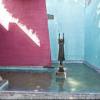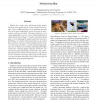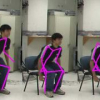CVPR
2008
IEEE
16 years 2 months ago
2008
IEEE
CVPR
2008
IEEE
16 years 2 months ago
2008
IEEE
115
click to vote
CVPR
2008
IEEE
16 years 2 months ago
2008
IEEE
In this paper, we describe a nonlinear image representation based on divisive normalization that is designed to match the statistical properties of photographic images, as well as...
CVPR
2008
IEEE
16 years 2 months ago
2008
IEEE
Motion blur retains some information about motion, based on which motion may be recovered from blurred images. This is a difficult problem, as the situations of motion blur can be...
121
click to vote
CVPR
2008
IEEE
16 years 2 months ago
2008
IEEE
To learn a new visual category from few examples, prior knowledge from unlabeled data as well as previous related categories may be useful. We develop a new method for transfer le...
141
click to vote
CVPR
2008
IEEE
16 years 2 months ago
2008
IEEE
Current approaches to pose estimation and tracking can be classified into two categories: generative and discriminative. While generative approaches can accurately determine human...
CVPR
2008
IEEE
16 years 2 months ago
2008
IEEE
Image blur is caused by a number of factors such as motion, defocus, capturing light over the non-zero area of the aperture and pixel, the presence of anti-aliasing filters on a c...
105
click to vote
CVPR
2008
IEEE
16 years 2 months ago
2008
IEEE
In this paper we present a hierarchical, learning-based approach for automatic and accurate liver segmentation from 3D CT volumes. We target CT volumes that come from largely dive...
119
click to vote
CVPR
2008
IEEE
16 years 2 months ago
2008
IEEE
This paper addresses human pose recognition from video sequences by formulating it as a classification problem. Unlike much previous work we do not make any assumptions on the ava...
CVPR
2008
IEEE
16 years 2 months ago
2008
IEEE
Unsupervised over-segmentation of an image into superpixels is a common preprocessing step for image parsing algorithms. Ideally, every pixel within each superpixel region will be...



